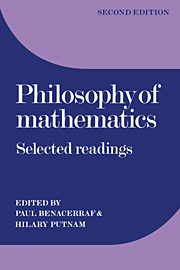Book contents
- Frontmatter
- Contents
- Preface to the second edition
- Introduction
- Part I The foundations of mathematics
- Part II The existence of mathematical objects
- Part III Mathematical truth
- Part IV The concept of set
- Russell's mathematical logic
- What is Cantor's continuum problem?
- The iterative concept of set
- What is the iterative conception of set?
- The concept of set
- Bibliography
The iterative concept of set
Published online by Cambridge University Press: 05 June 2012
- Frontmatter
- Contents
- Preface to the second edition
- Introduction
- Part I The foundations of mathematics
- Part II The existence of mathematical objects
- Part III Mathematical truth
- Part IV The concept of set
- Russell's mathematical logic
- What is Cantor's continuum problem?
- The iterative concept of set
- What is the iterative conception of set?
- The concept of set
- Bibliography
Summary
A set, according to Cantor, is “any collection … into a whole of definite, well-distinguished objects … of our intuition or thought.” Cantor also defined a set as a “many, which can be thought of as one, i.e., a totality of definite elements that can be combined into a whole by a law.” One might object to the first definition on the grounds that it uses the concepts of collection and whole, which are notions no better understood than that of set, that there ought to be sets of objects that are not objects of our thought, that ‘intuition’ is a term laden with a theory of knowledge that no one should believe, that any object is “definite,” that there should be sets of ill-distinguished objects, such as waves and trains, etc., etc. And one might object to the second on the grounds that ‘a many’ is ungrammatical, that if something is “a many” it should hardly be thought of as one, that totality is as obscure as set, that it is far from clear how laws can combine anything into a whole, that there ought to be other combinations into a whole than those effected by “laws,” etc., etc. But it cannot be denied that Cantor's definitions could be used by a person to identify and gain some understanding of the sort of object of which Cantor wished to treat.
- Type
- Chapter
- Information
- Philosophy of MathematicsSelected Readings, pp. 486 - 502Publisher: Cambridge University PressPrint publication year: 1984
- 5
- Cited by



